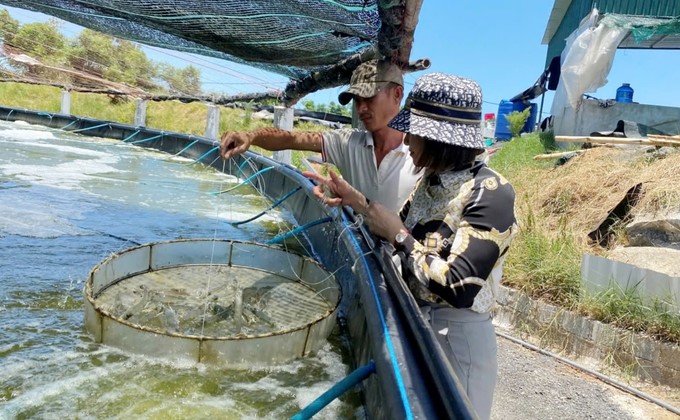November 19, 2025 | 13:34 GMT +7
November 19, 2025 | 13:34 GMT +7
Hotline: 0913.378.918
November 19, 2025 | 13:34 GMT +7
Hotline: 0913.378.918
Since 2023, the Quang Binh Agriculture and Fisheries Extension Center has implemented a model of two-stage whiteleg shrimp farming on canvas-lined ponds associated with a product consumption linkage chain.
According to Mr. Tran Thanh Hai, Director of the Quang Binh Agriculture and Fisheries Extension Center, the model has a scale of 2.7 hectares, with the participation of five households. Of which, 1.4 hectares were implemented in 2023, and 1.3 hectares are implemented this year. "We built a plan for farming productivity in the model to reach about 12 tons/ha. However, in reality, farmers have reached 19 tons/ha, so shrimp farmers earned big profits," said Mr. Hai.

Checking shrimp raised in stage 1 before moving to stage 2. Photo: T. Trang.
We returned to Quang Chau commune (Quang Trach district), where is implementing the two-stage shrimp farming model. Mr. Dam Van Thuyen, one of the households participating in the model, said that he has stuck to this "gambling with heaven" profession for many years and has also experienced many failures.
"To find a solid direction in my profession, I joined the model with the implementation support from the Provincial Agricultural Extension Center last year. Now I have grasped the production techniques and followed the instructions so the shrimp grows and develops well on schedule," excitedly said Mr. Thuyen.
Talking about two-stage shrimp farming, Mr. Thuyen said that stage 1 raises shrimp seeds with a density of 1,500 shrimp seeds/m2, and stage 2 raises commercial shrimp with a density of 135 heads/m2.
According to Mr. Thuyen, the difference between two-stage shrimp farming and traditional shrimp farming is that two-stage farming helps farmers control the growth process of shrimp and reduce the loss rate in the commercial shrimp farming stage.
After more than 2 months of farming, when checked, the shrimp in the pond of Mr. Thuyen's family had an average size of about 58–60 heads/kg. At this stage, shrimp are in good health and grow quickly. When shrimp reach the time of sale, they can reach a size of about 30–35 heads/kg.
This year, the Quang Binh Agriculture and Fisheries Extension Center continues to implement the two-stage shrimp farming model in Ha Trach commune (Bo Trach district). Ha Trach commune is a locality with a tradition of shrimp farming. However, in recent years, shrimp have suffered from frequent diseases and crop failures, so farmers have suffered losses. Since then, many pond areas have been abandoned.

Two-stage shrimp farming helps farmers control diseases and earn big profits. Photo: T. Trang.
To support farmers, the Quang Binh Agriculture and Fisheries Extension Center sent technical staff to guide the treatment of farming ponds before stocking shrimp and choosing suitable seeds. Ms. Ho Thi Thuy, Deputy Head of Technical Transfer Office (Quang Binh Agriculture and Fisheries Extension Center), said that the unit has guided farmers on how to care for shrimp in each stage, shrimp leveling techniques, etc.
"It is also important that farmers keep a daily log from stocking to harvest to firmly understand the status of shrimp in the farming pond and promptly handle any incidents," Ms. Thuy said.
As one of the farming households participating in the model, Mr. Le Chieu Quan (Ha Trach commune, Bo Trach district) said he has 0.6 hectares of two-stage whiteleg shrimp farming on the canvas-lined earthen pond.
"Practices on the family's pond show that the two-stage shrimp farming method contributes to limiting diseases and improving shrimp productivity and quality. In addition, farmers also control the environment and shrimp density during the farming process well," said Mr. Quan.
According to Ms. Ho Thi Thuy, shrimp products from the two-stage shrimp farming model always ensure traceability through farming logs, so they are suitable for the needs and tastes of the market.
"According to assessments, the model gives 15% higher productivity than traditional shrimp farming. The shrimp is VietGAP certified and is connected to product purchasing and consumption focal points, so farmers are proactive and feel secure in their production process," Ms. Thuy added.
As of now, about 70% of households in Quang Binh have switched to two-stage shrimp farming, concentrated in Quang Ninh, Bo Trach, and Quang Trach districts. Many farming households have applied methods of specialized farming, shrimp-fish farming, and intercropping in rice fields, bringing high economic efficiency.
Translated by Thu Huyen

(VAN) Ca Mau has a sufficient foundation to become a strong regional aquaculture center, where production integrates the economy, the environment, and the lives of the people.

(VAN) SEIKI Group envisions itself as a pioneer in the ‘dual transformation’ of digital technology and green industry, standing alongside the Government and Vietnamese businesses in their pursuit of sustainable development.

(VAN) The VNGEONET network affirms Viet Nam's progress in mastering digital space, providing a precise positioning data platform to serve socioeconomic development.
/2025/11/14/3247-1-184556_35.jpg)
(VAN) Thai Nguyen is methodically implementing digital transformation in the livestock sector, laying the foundation for a modern, transparent, and sustainable agriculture.

(VAN) The year 2025 marks 80 years of development of the Agriculture and Environment sector, a proud journey with significant progress in production, integration and sustainable growth.

(VAN) De Heus continues to steadfastly pursue sustainable development, building linked value chains with farmers and businesses in Viet Nam.

(VAN) From the rich lands of Co Do (Can Tho), an enterprise is amplifying the value of the clean rice grain, a symbol of the vitality and pride of the Mekong Delta.